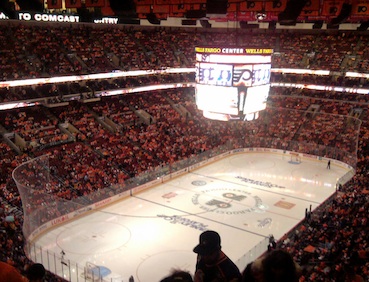- FM 97.5 is better known to Philadelphia sports fans as The Fanatic, and recent agreements with the Philadelphia 76ers and the Philadelphia Flyers gave its listeners a new reason to cheer. As of this season, the station will broadcast all 76ers and Flyers games in full FM stereo and full FM bandwidth, a substantial improvement over the previous station’s AM broadcasts.
Both teams play in The Wells Fargo Center, and Greater Media, the owner of FM 97.5, recognized that a substantial upgrade in its broadcast audio infrastructure would be required to deliver reliable, high-fidelity game day sound, in what is perhaps the one of the nation’s first Dante radio broadcast digital backbone system in a professional sports arena. Greater Media installed three Symetrix SymNet Radius 12x8 processors with built-in Dante digital audio networking. The SymNet Radius 12x8s gather inputs from three strategic locations in the Wells Fargo Center and deliver them with full fidelity and near-zero latency to the station’s codec.
“It was apparent that a lot of The Wells Fargo Center’s broadcast audio infrastructure might have been appropriate for the fidelity of an AM broadcast but that it wouldn’t work for an FM broadcast,” said Rodney Byrd, engineer with Greater Media. “AM is forgiving; FM is not.”
And because bringing the fidelity up to FM standards would require a complete overhaul, it was an excellent time to build an infrastructure that would be flexible, easy to use, and amenable to future changes.
“The Fanatic has the contract for multiple years, and the expectation is that they will renew,” explained Pat Conneen, an audio engineer who contracts with Greater Media, was an AV integrator, and is also a Symetrix rep. “So, they wanted to get it right from the start.”
Several issues presented themselves, but foremost was the disparate locations used by the players, the 76ers announcers, and the Flyers announcers. The players, of course, use the locker rooms and the main floor. The 76ers’ announcers use an area on the balcony, and the Flyers’ announcers use a space adjacent to the press box. The previous radio station physically moved its equipment several hundred feet depending on which team was playing. “It was clear to us that that was not what we wanted to do,” said Byrd. A better plan was to place a SymNet Radius 12x8 at each of the three locations and rely on its Dante network backbone to deliver audio to the Telos Zephyr Xstream codec via the SymNet Radius 12x8 located near the press box.
“Of course, cabling all of that up with copper would have been a tremendous and costly undertaking,” said Byrd. “In contrast, the Dante bus requires only CAT6 cabling, and it allows us to push signals from anywhere to anywhere within the network. We were originally considering using another manufacturer’s system with a proprietary digital network, but then Symetrix announced the SymNet Edge system [to which the Radius 12x8 is related]. The features, benefits, and industry acceptance of Dante made it the clear choice. Personally, both Rodney and I have history in the live sound industry, and there Dante is being used to send huge numbers of channels between inputs, and outputs of consoles. If it was working for that application, I was confident it would be robust for our needs.”
He continued, “I also knew that Symetrix has a longstanding reputation within the broadcast industry for delivering clear, high-fidelity audio. Its analog components are excellent, and its processing algorithms are transparent.”
The other major component of the installation is a pair of digital mixing consoles, a Soundcraft unit for the Flyers and a PreSonus unit for the 76ers. Signal processing duties are shared between the consoles and the SymNet Radius 12x8s. “The SymNet units are flexible enough to bring in either line inputs or mic-level inputs, so we have a lot of flexibility in terms of which inputs go where,” said Byrd. “We’re still working out exactly how we want to control them on a day to day basis, but the most likely solution will be to create custom SymVue panels for a PC interface.” Because the Radius 12x8s are easily IP addressable, the station can make changes to the system either at the arena or remotely from its broadcast studios.'










